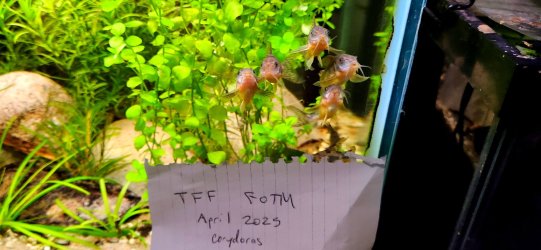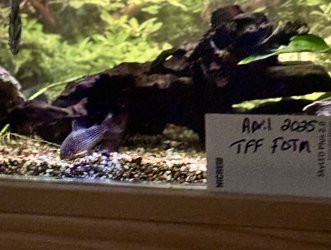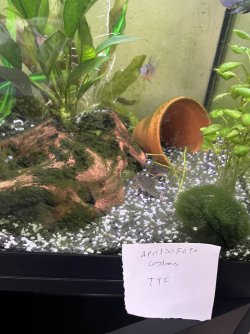I have 7 species of corydoras at the moment, it made it very, very difficult to choose which for this contest

In the end, I've opted for a sentimental species rather than one of my more flashy species.
Several years back I started with a group of hoplisoma trilineatum and then added a couple hoplisoma paleatum. These made up my first groups of cories and basically were my gateway to several others.
However, these fish ended up needing to be culled 1.5 years ago because of camallanus worms that became drug resistant and would not go away. However, a week before the cull, upon cleaning the tank, I had came across a bunch of cory eggs. I collected them and separated them to a separate nursery. At this point, they could have been any species from that tank (paleatum, panda, elegans, trilineatum, weitzmani). I didn't know for a couple weeks until the fry developed more.
I was devastated to lose that entire tank, a massive amount of my corydoras as well.
But, those fry I raised turned out to be hoplisoma paleatum, and when I rebuilt the tank after a couple months of leaving it dry and getting it back all cycled, I built the setup around them. 13 hoplisoma paleatum raised from my original group. I added 2 unrelated males to the group, totalling me 15 of them now, since the ones I raised ended up all being female anyways.
So, this is Fish. She is one of those hoplisoma paleatum I raised from my original group of lost fish. She is named Fish because if you look at one of her dark spots on her side, it is shaped like a little cartoon fish, or even a Goldfish cracker. It is a unique marking to her, none of her sisters share the same mark.
These paleatum are very valuable to me, even though they are one of the most common cories in the hobby. They're a small piece I've got from my originals, and now in turn, they themselves have bred and I've now raised a third generation as well.
This species may be common in the hobby, but I feel that it's unique patterns among the individuals can differentiate them to us better so we can give them unique names and know which is which fish. They also can grow to a good size, I've had a female from my original group reach over 3 inches. They tend to be more lanky in build compared to the most common in the hobby, osteogaster aenea. In good lighting, they shine with a foil-like blue iridescence, which is especially bold on their face and gill plates. This species comes from regions far south in South America, often from relatively cold water. Wild fish are known to come from habitats as cold as 59.9°F! The species tends to do better when kept cooler, even compared to other cories who also do better in cooler temperatures.
If noticed, I am calling them by their new name, hoplisoma paleatum. They used to be called corydoras paleatus, but late 2024 they were among the rest of the corydoras lineages that were reclassified to several new genus names.
Care info:
Temperature: 59.9-77°F or 15-25°C
Parameters: pH 6-7 | 1-12°DGH
Origin: Paraguay, Uruguay, Brazil
Tank size: 20 gallon long for 6 fish to start
Diet: mostly insectivorous, vegetation is very limited in their diet. An insect based pellet with a rotation of frozen or live foods is best, algae wafers should remain a treat.
Other needs: sand substrate is a must, keeping in groups is a must. Appreciates good water flow. A mature setup is necessary as they are sensitive to swings in parameters common in immature tanks.








